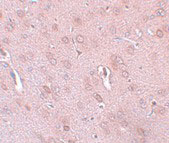TRESK Antibody
- SPECIFICATION
- CITATIONS
- PROTOCOLS
- BACKGROUND

Application
| WB, IHC-P, IF, E |
|---|---|
| Primary Accession | Q7Z418 |
| Other Accession | NP_862823, 32469495 |
| Reactivity | Human, Mouse, Rat |
| Host | Rabbit |
| Clonality | Polyclonal |
| Isotype | IgG |
| Calculated MW | 43671 Da |
| Application Notes | TRESK antibody can be used for detection of TRESK by Western blot at 1 - 2 µg/mL. Antibody can also be used for immunohistochemistry starting at 5 µg/mL. For immunofluorescence start at 20 µg/mL. |
| Gene ID | 338567 |
|---|---|
| Target/Specificity | KCNK18; |
| Reconstitution & Storage | TRESK antibody can be stored at 4℃ for three months and -20℃, stable for up to one year. As with all antibodies care should be taken to avoid repeated freeze thaw cycles. Antibodies should not be exposed to prolonged high temperatures. |
| Precautions | TRESK Antibody is for research use only and not for use in diagnostic or therapeutic procedures. |
| Name | KCNK18 {ECO:0000303|PubMed:22355750, ECO:0000312|HGNC:HGNC:19439} |
|---|---|
| Function | K(+) channel that conducts outward and inward rectifying currents at depolarized and hyperpolarized membrane potentials, respectively. The outward rectifying currents are voltage-dependent, coupled to K(+) electrochemical gradient across the membrane, whereas the inward currents can be induced in response to activation of Ca(2+)- mobilizing receptors (PubMed:12754259, PubMed:15562060, PubMed:20871611, PubMed:22355750, PubMed:26919430, PubMed:30573346). Homo- and heterodimerizes to form functional channels with distinct regulatory and gating properties. In trigeminal ganglia sensory neurons, the heterodimers of KCNK18/TRESK and KCNK2/TREK-1 or KCNK10/TREK-2 inhibit neuronal firing and neurogenic inflammation by stabilizing the resting membrane potential at K(+) equilibrium potential as well as by regulating the threshold of action potentials and the spike frequency (By similarity). In thymocytes, conducts K(+) currents upon T cell receptor (TCR) signaling leading to sustained Ca(2+) influx and NF-kappa-B activation, FOXP3 transcription and positive selection of regulatory T cell (Treg) progenitor subsets (PubMed:34702947). Appears to mediate the analgesics effects of hydroxy-alpha-sanshool, a metabolite naturally present in Schezuan pepper and other Xanthoxylum plants (By similarity). |
| Cellular Location | Cell membrane; Multi-pass membrane protein |
| Tissue Location | Expressed in dorsal root ganglion and trigeminal ganglion neurons. Detected at low levels in spinal cord. Expressed in regulatory T cells (at protein level). |

Thousands of laboratories across the world have published research that depended on the performance of antibodies from Abcepta to advance their research. Check out links to articles that cite our products in major peer-reviewed journals, organized by research category.
info@abcepta.com, and receive a free "I Love Antibodies" mug.
Provided below are standard protocols that you may find useful for product applications.
Background
TRESK Antibody: TRESK (TWIK-related spinal cord K+ channel) is a two-pore domain K+ channel that induces outward rectification and functions as a background K+ channel that is abundantly expressed in the spinal cord, thymus, spleen, and leukemic T-lymphocytes. TRESK is activated by increased cytoplasmic calcium concentration through calcineurin as well as by acetylcholine and histamine. It has been suggested that TRESK is linked to acute and chronic pain by activation of calcineurin. Other studies indicate that TRESK may play a role in the regulation of T-cell function and could be an excellent target to treat T-cell originated immune dysfunction.
References
Sano Y, Inamura K, Miyake A, et al. A novel two-pore K+ channel, TRESK, is localized in the spinal cord. J. Biol. Chem.2003; 278:27406-12.
Han J and Kang D. TRESK channel as a potential target to treat T-cell mediated immune dysfunction. Biochem. Biophys. Res. Comm.2009; 390:1102-5.
Czirjak G, Toth ZE, and Enyedi P. The two-pore domain K+ channel, TRESK, is activated by the cytoplasmic calcium signal through calcineurin. J. Biol. Chem.2004; 279:18550-8.
Huang DY, Yu BW, and Fan QW. Roles of TRESK, a novel two-pore domain K+ channel, in pain pathway and general anesthesia. Neurosci. Bull.2008; 24:166-72.
If you have used an Abcepta product and would like to share how it has performed, please click on the "Submit Review" button and provide the requested information. Our staff will examine and post your review and contact you if needed.
If you have any additional inquiries please email technical services at tech@abcepta.com.













 Foundational characteristics of cancer include proliferation, angiogenesis, migration, evasion of apoptosis, and cellular immortality. Find key markers for these cellular processes and antibodies to detect them.
Foundational characteristics of cancer include proliferation, angiogenesis, migration, evasion of apoptosis, and cellular immortality. Find key markers for these cellular processes and antibodies to detect them. The SUMOplot™ Analysis Program predicts and scores sumoylation sites in your protein. SUMOylation is a post-translational modification involved in various cellular processes, such as nuclear-cytosolic transport, transcriptional regulation, apoptosis, protein stability, response to stress, and progression through the cell cycle.
The SUMOplot™ Analysis Program predicts and scores sumoylation sites in your protein. SUMOylation is a post-translational modification involved in various cellular processes, such as nuclear-cytosolic transport, transcriptional regulation, apoptosis, protein stability, response to stress, and progression through the cell cycle. The Autophagy Receptor Motif Plotter predicts and scores autophagy receptor binding sites in your protein. Identifying proteins connected to this pathway is critical to understanding the role of autophagy in physiological as well as pathological processes such as development, differentiation, neurodegenerative diseases, stress, infection, and cancer.
The Autophagy Receptor Motif Plotter predicts and scores autophagy receptor binding sites in your protein. Identifying proteins connected to this pathway is critical to understanding the role of autophagy in physiological as well as pathological processes such as development, differentiation, neurodegenerative diseases, stress, infection, and cancer.




